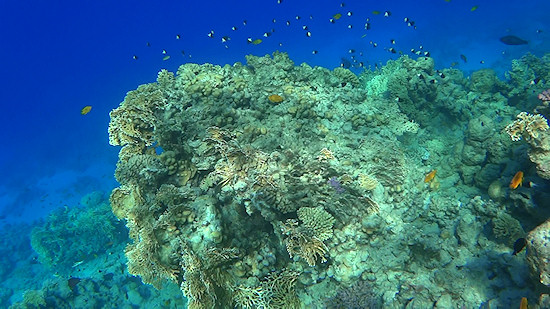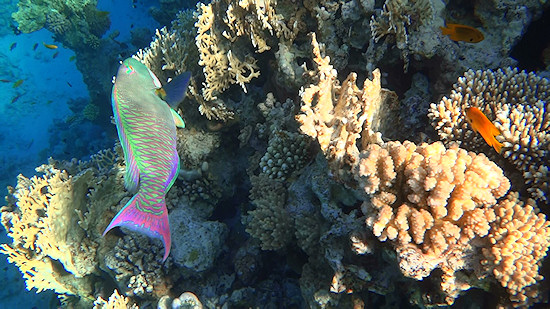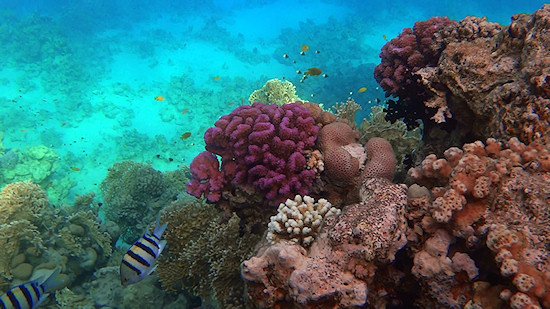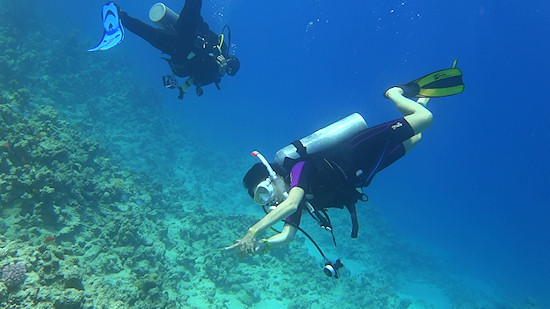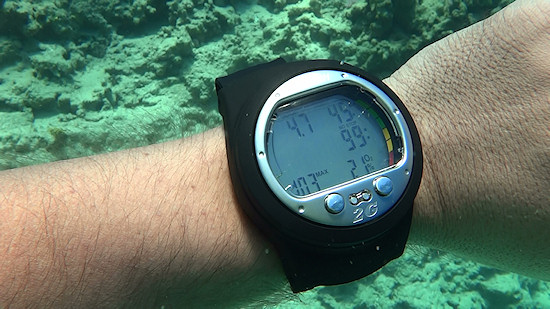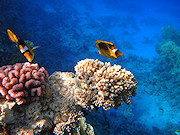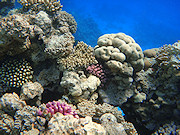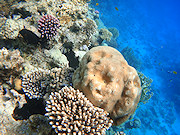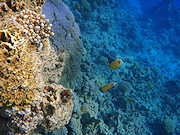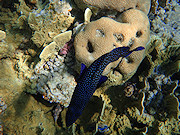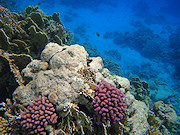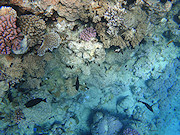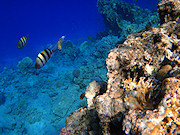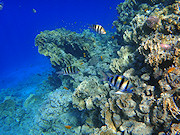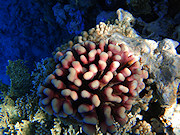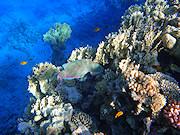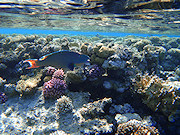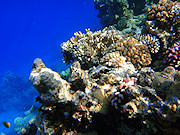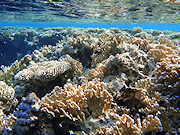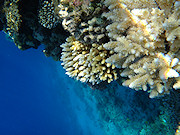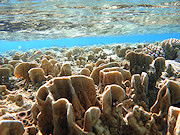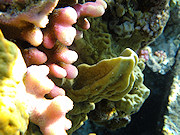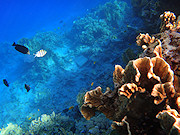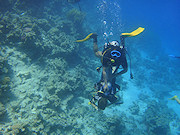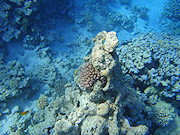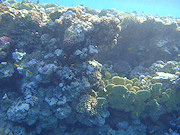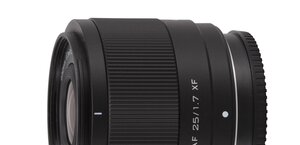Underwater cameras test 2011
6. Sony Cyber-shot DSC-TX10
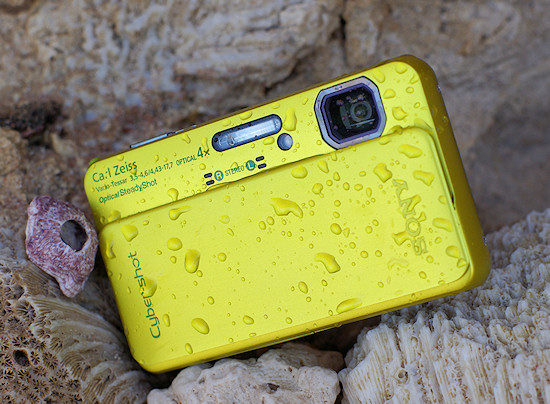 |
The history of the Sony Cyber-shot TX cameras series is quite short because it started two years ago with the launch of the TX1 model. Although from that time we’ve been shown other five models of this line of stylish compacts, only two of them were designed to work underwater. The first, the TX5, we tested one year ago, the second, the Cyber-shot TX10 had its launch at the beginning of this year.
The camera was also equipped with a new 16 Mpix CMOS Exmor R sensor, which, joined with the BIONZ processor, gives you a possibility to recording Full HD 1920X1084 50i videos using the AVCHD coding. The new model also features an LCD touch screen 3 inches in diameter which resolution increased to 921K points.
The durability parameters of the camera also changed – now it can be submersed up to a depth of 5 m. It is not a staggering value but still better than 3 meters, the limit of the TX5. The reinforcing of the body didn’t translate into the change of its dimensions – they are practically identical compared to the older model – but the weight diminished by 10 grams. Other significant changes include adding the support of SDXC cards and an underwater panoramic mode.
Please Support UsIf you enjoy our reviews and articles, and you want us to continue our work please, support our website by donating through PayPal. The funds are going to be used for paying our editorial team, renting servers, and equipping our testing studio; only that way we will be able to continue providing you interesting content for free. |
- - - - - - - - - - - - - - - - - - - - - - - - - - - - - - - - - - - - - - - - - - - - - - - -
In the TX10 the same Carl Zeiss Vario-Tessar lens as in the older model was used. It features the equivalent of 25-100 mm focal lengths range and an aperture which varies from f/3.5 to f/4.6. Those who want to compare the parameters of the TX5 and the TX10 should consult an appropriate chart.
Design and build quality
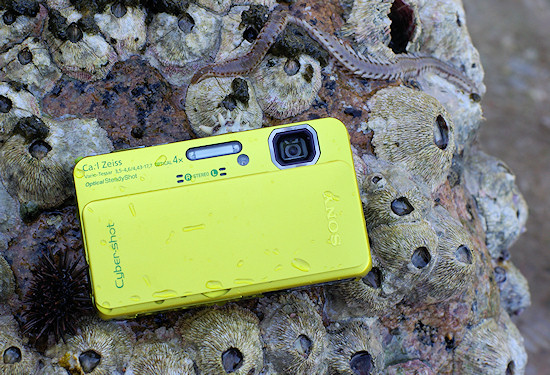 |
The style of the TX10 refers to the previous models from this series which one characteristic feature - a sliding panel hiding the lens and a flash. Almost all the body was made of aluminum and two covers hiding ports and a border around the LCD screen are the only plastic elements there.
Speaking about the covers it’s worth mentioning here that the first one was positioned on a side panel and it protects an HDMI port and a multi-function port which might work as an USB 2.0 or an audio-video port or a power socket.
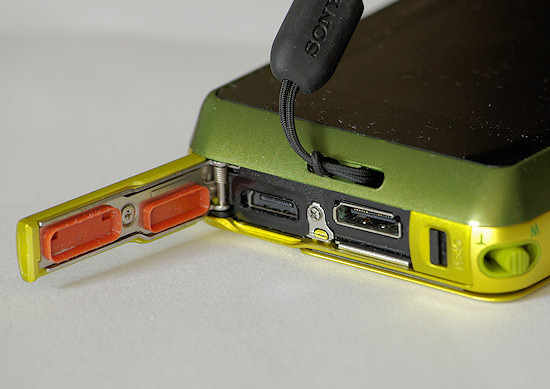 |
The second cover was put on the bottom panel and behind it you can find a battery and a memory cart slot. As it is quite big the tripod socket had to be moved a bit off the camera central axis. However, it is not on the edge of the casing which position would make using a tripod very difficult indeed.
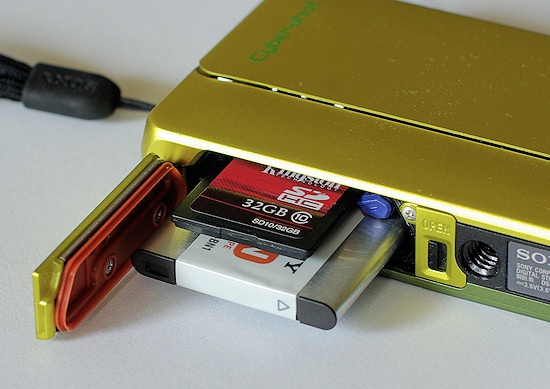 |
Although the covers weren’t equipped with a blockade, the opening levers don’t stick outside the casing so there is no danger you might open them accidentally under water. People with short fingernails might have some problems with operating them, though. You are informed about the fact that you closed everything correctly when you hear a characteristic click and a yellow marker next to the lever disappears. It is a simple process and it doesn’t require as much force as in the case of the Fujifilm XP30.
The number of buttons on the casing of the TX10 was limited to the minimum because most of their functions were taken over by the touch LCD screen which occupies the whole surface of the back panel.
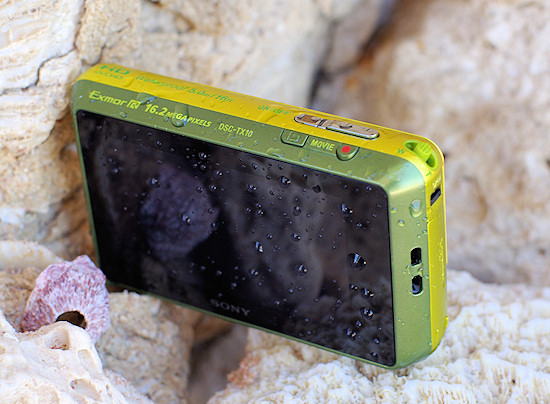 |
At the top of the camera we get an ON/OFF key, a shutter release, a video mode button and a playback button. The list of all manipulators is closed by a small zoom toggle.
Although the whole body is not much bigger than a credit card it appears to be a very sturdy device. The casing is stiff, its elements well-fitted and the buttons move without slacks. The sliding mechanism of the lens-protecting cover deserves out praise as well – it works much better than in the previous model. Apart from that the cover was made uniform with the front panel so it doesn’t stick outside and during the opening it moves a bit away from the plane of the panel. It has a positive impact on the operation of the camera.
Use, cleaning, wear and tear
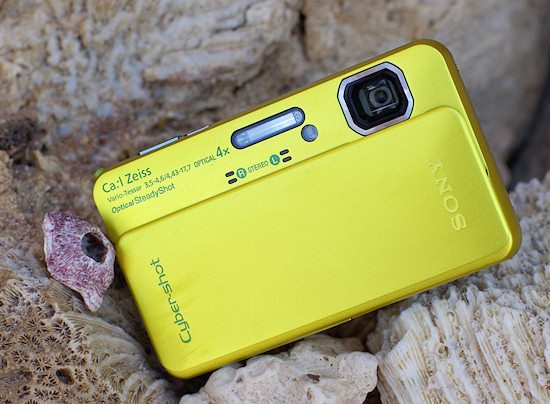 |
The cleaning of the Sony TX10 is really problem-free. The casing is smooth and devoid of any nooks where the dirt could hide so we shouldn’t worry too much if we forget to rinse it in fresh water after getting out of the sea. The sea salt doesn’t degrade the coatings which cover the elements of the casing so in the case of the TX10 we don’t experience such problems as with the TX5 (namely peeling off varnish covering the front lens cover)
Our test didn’t leave the slightest trace on outer metal and plastic elements of the new Cyber-shot camera so the device should be praised here. Unfortunately we can’t say the same thing about the LCD screen’s protecting window – we didn’t have a lot of problems with finding several deep grooves so it is hardly scratch-free.
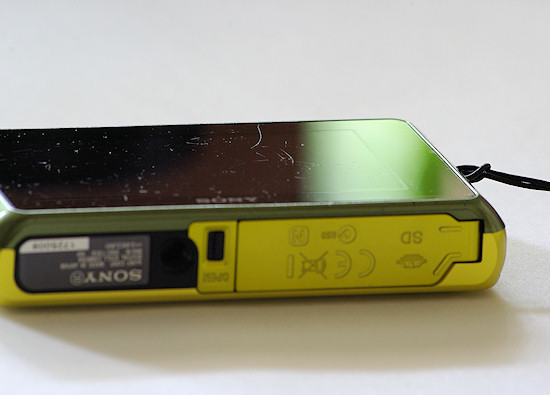 |
Additional functions
Although the camera wasn’t equipped with an GPS module, a compass of a depth gauge it is clear the producer focused on the function of sweep panorama photos. The Sony offers the most options here and the same process is really a piece of cake. It’s enough you press the shutter release and move the camera toward your chosen direction (left, right, up, down) to see after a while a nice and ready panoramic shot. The TX10 additionally offers us a standard panorama, a wide panorama or a high resolution panorama, where the particular photos are joined vertically.As if it wasn’t enough, the Sony offers a quite unique function – an underwater panorama, in which the white balance parameters are chosen in such a way as to render the colouring of an underwater world the best.
Of course we didn’t omit to check it and below you can see several panoramic shots taken at 5 m.
Click to enlarge. |
This function works splendidly and the results honestly exceeded our boldest expectations. Although the colouring is perhaps not perfect, these panoramas are so well-done that during one diving session you can take several dozens of such photos. We must admit we had a problem with choosing the sample shots for this section – we simply liked the majority of them. We limited our choice to just 10 photos here with a broken heart.
During snorkeling we also can get interesting panoramas but with higher waves it is definitely more tricky because the camera has problems with joining the photos and sometimes aborts the recording mode. As a result our panorama is often unfinished.
Click to enlarge. |
Despite that fact, the producer deserves our praise for making such an interesting function available.
Underwater usage
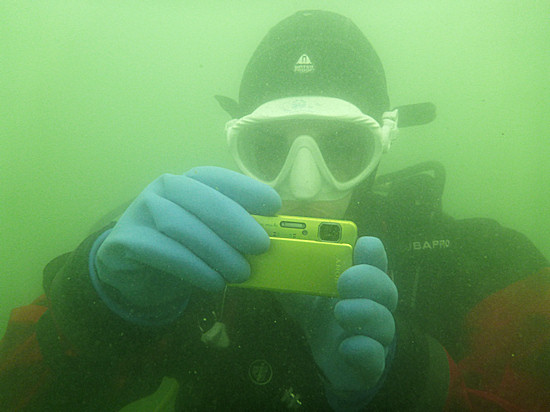 |
If we wanted to be mean we should shrug this subsection off by writing: underwater usage – lacking! All because of a sensor used in this camera which switches off the touchable interface as soon as you submerge with the camera in water. It means we have no possibilities to control any parameters underwater – we are left with just zooming and the video button.
First we started to wonder for what the reason the constructors decided to make our life so difficult. A probable answer was quickly found. In previous chapters we showed how the water pressure at greater depths makes the protective window of the LCD screen bend inwards. In the Sony TX5 such problem didn’t exist but only because you can’t dive with this camera deeper than 3 m, where the pressure is still not so big. At 5 m, the maximum diving depth of the TX10, the situation is already different. We presume the constructors must have noticed during their tests that at that depth the LCD screen was under such a pressure that the touch sensors were being activated randomly and the camera couldn’t work properly. If in the case of the Fujifilm XP30 at a similar depth the pressure could make the buttons decrease spontaneously it wouldn’t be so difficult to imagine its influence on a touchscreen would be even greater.
It’s worth glancing how the screen of the TX10 looks at the depth of about 5 meters.
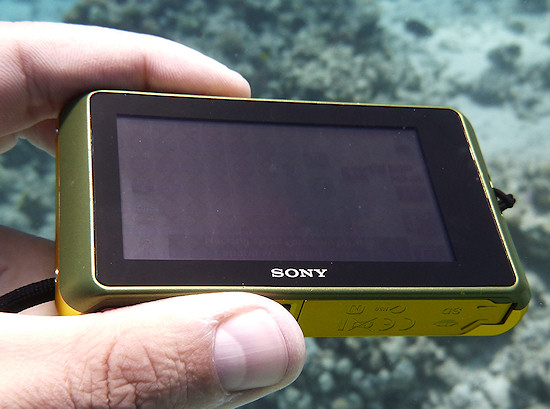 |
The photo above confirms our speculations because the surface of the monitor is clearly being pressed.
It’s obvious that the producer, offering an underwater camera with a touchscreen, went down a blind alley and, unfortunately, decided to get out of that tight corner in the worst possible manner – making any operations underwater impossible. As a result we didn’t take many photos with the TX10 at greater depths because during one diving session with this camera we had the panoramic photo function activated and we couldn’t switch to another mode.
The tested Cyber-shot offers three white balance options for underwater photos but they are hardly needed when you can’t switch between them under water. Even during snorkeling it is really very bothersome – you must resurface every now and then just to change the settings. If you add to it a not especially big panoramic screen, practically illegible against bright sunlight, we get a disgraceful winner of our ranking for the least user-friendly underwater camera.
As if it wasn’t enough, the body is difficult to keep in wet hands because the camera is small and slippery and the lens was positioned in such a way that sometimes we can take a photo of a bit of our own finger. The shape of the buttons also weren’t well thought out – they are simply microscopic and too close together.
Let’s finish off the loser now and describe the touchable interface of this camera. It still is pretty demanding – you must constantly press the screen to change anything. Switching between the modes is as time-consuming as in the older model.
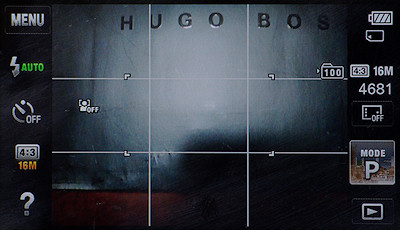 |
For instance if you want to switch from the P mode to the underwater mode you have to:
- click on the Mode P icon on the cropping screen
- choose “scene selection” marked as the “SCN” icon
- move the toggle, situated on the right, downwards
- choose the underwater mode icon
- choose “OK” near the communicate informing you that you should check whether there are no alien objects inside the battery cover and it is properly closed.
Fortunately the producer made our tortures a bit less painful; pressing the Movie button makes video recording start in the currently chosen thematic mode. However the mere switching from the photographic to the video mode lasts about 5 seconds and the return takes next 6 seconds during which all we see is the “Recording” message.
Luckily the autofocus is very quick and its accuracy is simply beyond reproach. Even when you shoot among high waves most of photos are sharp. Apart from that the camera manages the right colour rendering well when you take dry land photos in the underwater mode (under the condition that we set the automatic white balance).
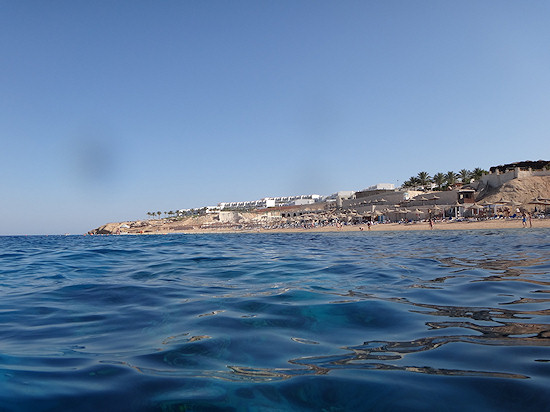 Dry land photo taken in the underwater mode |
Small thing but nice. Always a little bit less tapping.
Underwater movies and photos quality
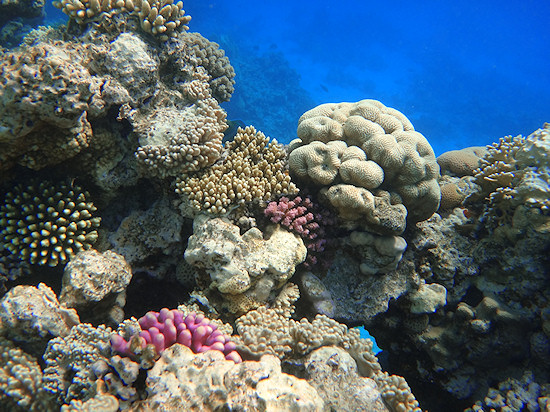 |
At least in this category the tested Sony didn’t disappoint us. The pictures, taken with this camera during snorkeling are admiringly colourful and rich in detail. The camera performs perfectly well in difficult conditions, e.g. when we are taking photos under water against the source of light. The colours are perhaps not so intensive then but still they look very nice. You can really feast your eyes on the view when you point the camera toward the depths of the sea, having the Sun behind our back. The variety of colours is almost completely the same as what we see in reality. We can boldly state here that in this category the TX10 is definitely the best among all this year’s tested compacts. Just some tiny reservations you can have when it comes to the image quality clearly deteriorating in the frame corners.
Additionally, apart from the automatic white balance settings (AWB) the producer offers us two manual options just for underwater pictures. According to the description, the first one (WB1) should be used in blue waters and the second one (WB2) in green waters.
In order to illustrate how these options work we are presenting below sample photos taken while using three different white balance settings. The scenes were shot during snorkeling because, as you remember, underwater you can’t change the camera’s settings.
|
|
|
|
|
|
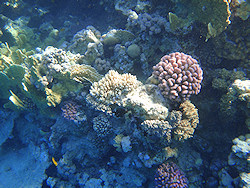 |
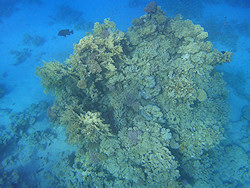 |
|
|
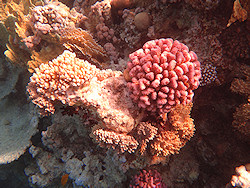 |
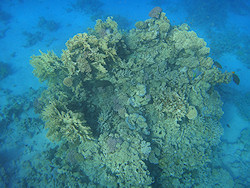 |
|
|
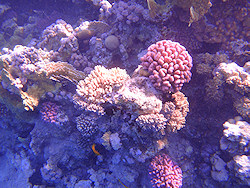 |
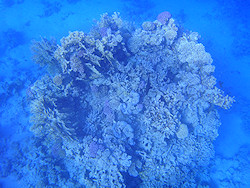 |
It is pretty clear that in blue waters the automatic white balance fares the best. When you choose the setting dedicated specifically for blue waters at shallow depths you get purple cast and at greater depths there is practically no difference between results achieved using the automatic mode and this one. The WB2 setting, dedicated for green waters, is no good for blue waters at all.
We decided to check how it works in green waters of lake Kłodno.
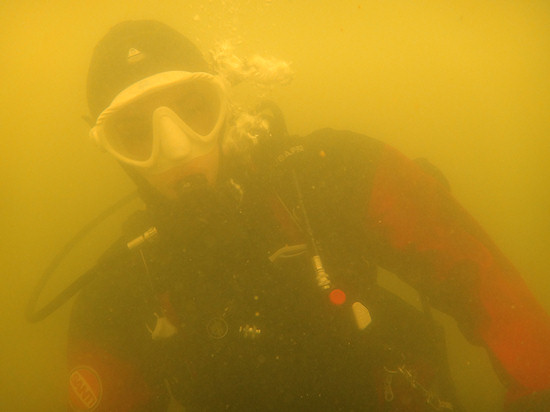 Click to enlarge. |
The result is less than average. The water in the pictures is yellow; in reality it had a slightly greenish hue.
At greater depths the Sony performs outstandingly well. The colours in the photos are very natural, without any blue dominant. They even look better than those from the Panasonic FT3 because we definitely like more the colour of the sea depth here. The close-ups of the coral reef themselves look a bit worse for a change because the TX10 can’t bring out real colours as well as the Lumix.
Apart from that you must remember that with the Sony we could only dive as deep as 5 m and at such a depth the conditions are much better than deeper in the sea, where we took the FT3, the TG-810 and the WG-1 with us.
Let’s pass to the movies now. After watching them only one word comes to your head : A SENSATION! Although the level of detail rendering is close to that offered by the Panasonic FT3 the Sony outclasses that rival with its colouring. No matter whether we go snorkeling or diving at 5 m, the TX10 is always up to the scratch giving us beautiful videos. Even when the sea is rough the autofocus never stops being accurate and very quick.
Summary
At the beginning a list of pros and cons of the tested camera:
-
Pros:
- focal length of the lens starting from the equivalent of 25 mm,
- easy to clean,
- splendid sweep panorama modes,
- underwater panoramas,
- very quick and accurate autofocus,
- very good rendering of the sea depth colour,
- splendid rendering of the coral reef colouring,
- perfectly detailed underwater photos,
- very good colouring of dry land photos in the underwater mode,
- sensational rendering of details in underwater movies,
- great colouring of underwater videos,
- two white balance options for underwater movies.
- waterproof up to only 5 m,
- scratch-prone LCD,
- slight, slippery casing difficult to hold in wet hands,
- bothersome drying of the camera,
- slight lag in menu navigation,
- lens set in wrong place,
- LCD screen not very legible underwater and against bright sunlight,
- lack of possibilities to change the parameters under water,
- small, uncomfortable buttons,
- in order to change into Auto mode you must enter the menu,
- weak colouring of photos taken in green waters,
- slow start of video mode and slow saving of recorded movies.
Cons:
As a kind of consolation we get that fantastic underwater panorama function, which is totally praiseworthy. It would be really good to put such great electronics into a bigger body which would withstand the depth of 12 m. If you give up that touchscreen, added a GPS module, a mode selection wheel, all the time keeping the price on the current level so about 1,200 PLN we would get a perfect camera. Meanwhile we are left with the TX10, which shoots the best photos and records the best underwater movies but sometimes you simply don’t feel like going into water with it – why bother so much?
Sample underwater videos
Sample underwater shots




